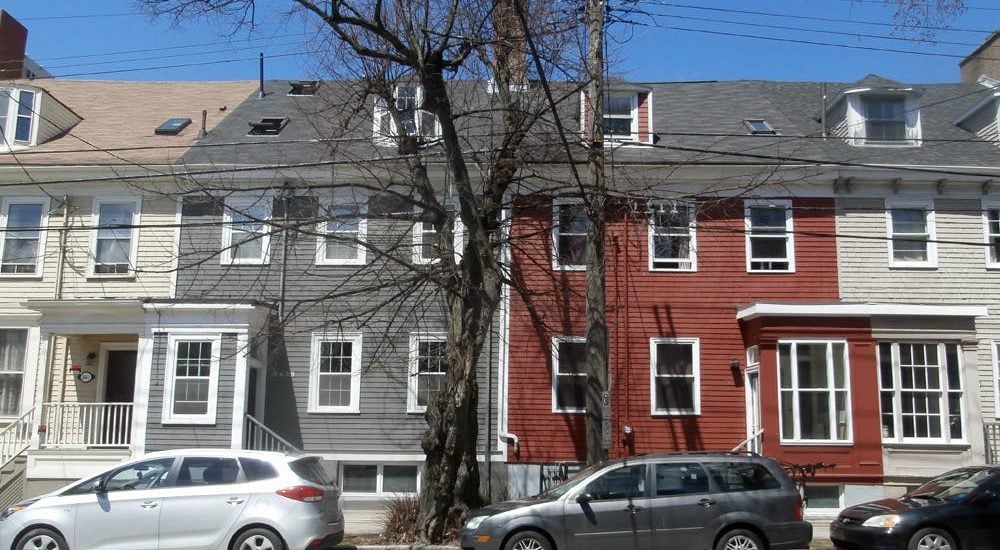KJIPUKTUK (Halifax) – Presentation delivered on Monday by Larry Haiven, speaking on behalf of the Friends of Schmidtville, to an all-party committee reviewing a proposal to eliminate capped property assessments in Nova Scotia.

While our neighbourhood is unique in many ways, it is also typical of many older urban districts, to which those concerned with municipal finance should pay special attention. Our community is one of those that combine relatively high property values yet relatively low incomes. Our fear is that, allowed to run free, tax assessment based on the vagaries of the market could seriously damage a wonderful, diverse and still-affordable neighbourhood.
Friends of Schmidtville is a community association representing residents, property owners and businesses in the the oldest/largest/contiguous historical neighbourhood in Halifax, perhaps in the province, with most buildings going back more than 150 years and some more than 200 years. Friends of Schmidtville was formed in 2008 to promote not only our historical importance but our social, economic and cultural identity.
We applied for Heritage Conservation District designation to Halifax Regional Municipality in 2009. In 2018, we became the second such district in the city to be so designated.
Looking only at the six city blocks within our boundaries, it is one of the densest neighbourhoods in Halifax. Chock-a-block with houses, Schmidtville is in a similar population density league as Paris and Barcelona. Yet the height limit is only 35 feet maximum, proving that we can achieve much of the density we want in this city simply by protecting our older neighbourhoods.
But there’s more to older neighbourhoods. Schmidtville has a great mix of incomes, and 75 percent of our residents are renters. The 2016 census shows the median individual annual income of Schmidtville residents as $25,439.
This is what affordable housing looks like. Half of us make less than that $25,000. And yet with 30 percent making above $50,000 and a few above $100,000, this is also what economic diversity looks like.
As everywhere on the peninsula, there is some gentrification going on. But Schmidtville’s is a slow and sustainable type, not what happens when you demolish houses and replace them with a bunch of pricey condos or apartments. We like to call it “gentle-fication.” And, we assure you, had we not organized, our neighbourhood would have been lost to high rises. We know, because even during the fight for heritage protection, we lost almost 10% of the neighbourhood to the wreckers ball.
As far as the goals of Halifax or any other city, Schmidtville is the almost nearly perfect neighbourhood.
In 2017, Schmidtville was declared by the Canadian Institute of Planners that year’s “Great Place in Canada.” The CIP wrote “As one of Halifax’s first suburbs outside the fortified fences, Schmidtville is a largely intact area of architectural character with significant heritage value, reflected in its narrow streets and old world charm. The City of Halifax has recognized the value in preserving mixed use neighbourhoods in the downtown for decades, making investments in public infrastructure that enhance the design and architectural features. Similarly, many residents have also renovated their homes, further contributing to the appeal of the area.”
Figure 1
A significant proportion of property owners have been in the neighbourhood over fifty years, some over eighty years. One family lived in the same house for about 135 years, until the last owner-resident died a few years ago. The drastic rise in housing prices began only about twenty years ago while incomes have remained stagnant (see the attached chart, Figure 1). Property values are a poor proxy for incomes here. If property assessments are uncapped and market forces allowed to run free, then some of those residents will have to sell their houses (and move where?) That will likely lead to intense, muscular gentrification, a decrease in owner-residents, a drastic rise in rents, proliferation of short term rentals and decline in long-term rentals. And we will lose what makes us unique and so valuable in the Nova Scotia political economy.
The myth some would like to foster is that if we could only induce people like me and my neighbours to move, young families would be ready to move in. But that’s not true. The ridiculous property values make it so that young families could not afford to buy our houses, no matter what the taxes. In fact, most of us could not afford to buy our own properties, that we bought when prices were more sane. The purchasers of our homes will more likely be speculators and absentee landlords ready to subdivide them into quickie rentals.
A presentation to your committee by the Canadian Centre for Policy Alternatives – Nova Scotia proposed moving from a property-based method of municipal revenue generation to one that is income-based, part of our provincial income tax. Such a move would go a long way toward correcting the problem.
We recognize that the present system of capped assessments has led to some distortion and inequalities. But whatever we do, we need to make sure that the cure is not worse than the complaint. It is true that many of us have taken great care to maintain and improve our homes and our neighbourhood in recent years. But that accounts for only a small fraction of the exploding property values. As you can see, those exploding property values are more a curse than a blessing if we cannot preserve the values of community, solidarity, and social cohesion.
Some presenters to this committee have insisted that the assessment cap slows down the buying and selling of properties. They maintain that the more transactions, the more economic activity, the better, that it’s all good, for everybody. Well it’s not. There are some things more important than commerce, more necessary than commissions on real-estate-flipping.
In his very thoughtful 2001 book “Social Cohesion and Economic Prosperity” economist Jeff Dayton-Johnson (formerly of Dalhousie University) quotes Nova Scotia novelist Ernest Buckler’s 1952 book The Mountain and the Valley. Recalling his formative years in the Annapolis Valley, Buckler uses the phrase “knitted warmth” to describe the bonds of closeness in his community. Dayton-Johnson asks “Can social cohesion make economies run more smoothly? Do societies where people are more prone to join groups and volunteer and where people trust one another more, have faster rates of growth?”
“In fact,” Dayton-Johnson concludes, “market economies rely on…social cohesion to function effectively, and to the extent that current changes in policies tend to diminish social cohesion, they will weaken the effectiveness of the market economy to deliver livelihoods and innovation.”



